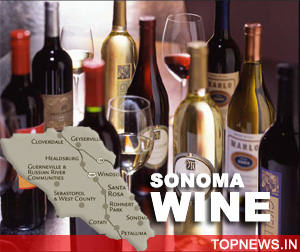A valley with history: California's Sonoma winemaking region
 Sonoma, California - Californian wines are now a long established part of European connoisseurs' drinking habits, the most popular of which are varieties from the Napa Valley region.
Sonoma, California - Californian wines are now a long established part of European connoisseurs' drinking habits, the most popular of which are varieties from the Napa Valley region.
But the West Coast state is home to another winemaking area, Sonoma, which boasts no less than 4,100 square kilometres of vines.
More than 250 vineyards are located in Sonoma, many of which have a winemaking tradition which is over a century old. A few claim to have roots in Europe's vineyards.
Thirteen different varieties of grape are grown in Sonoma, a region about the size of the smallest US state, Rhode Island, or Luxembourg.
According to winemaker Walter Schug, Sonoma is divided into climatically different areas: winds from the Bay of San Francisco blow as far south as Carneros, creating cool temperatures; in other areas, rain and mist are common.
Schug, 72, left his birthplace in the Palatinate region of Germany about 50 years ago and made his way with his wife to Hamburg, where they boarded a ship bound for New York.
After crossing the United States, he eventually reached his present abode where he pursues his profession and hobby: winemaking.
Schug produces red, white and sparkling wines on a 8-hectare vineyard.
But Sonoma is not only a vine-growing region, everything grows well there, including anything that needs lots of sun and can be turned into a product that reaches high prices in the shops.
Olive trees, lavender bushes and orchard trees line the highways reminding you less of southern France's winemaking areas than of Austria with its green pasture lands, cows and forests and where you can stroll all day admiring redwood trees without ever meeting a soul.
Sonoma is also known as the Valley of the Moon, but its history has not always been as calm and pleasant as the name would have people believe.
In June 1846, the Bear Flag was raised above Sonoma's town square by a group of Mexicans. It was the first act in the declaration of California as independent from Mexican rule.
There followed a conflict that in the north of the state continued without a single shot being fired. The United States of America eventually claimed California's Pacific coastline and the Bear Flag was retained to become the state's official flag.
Sonoma's winemaking valley is not the only famous feature in the region. An 80-kilometre stretch of coastline from Gualala in the north to Bodega Bay in the south has its place in filmmaking history.
In 1961, film director Alfred Hitchcock was inspired by the small community of Bodega Bay with its barren hills, fishing harbour and foggy climate and used the place as the setting for his classic movie The Birds.
Horror movies have since moved on and become even more frightening, but Hitchcock's movie established Bodega in the minds of many people.
"They come here to look around and see the spots where Tippi Hedren (lead actress in the film) was attacked by the birds," says tourist manager Tina Luster.
Visitors also like to travel above the craggy Pacific coast along the road that Hedren raced down in her fancy sports car - something that locals are not wont to do.
"We just come here to sit on the beach, to look out over the ocean and watch the whales."
Internet: www. sonomacounty. com (dpa)